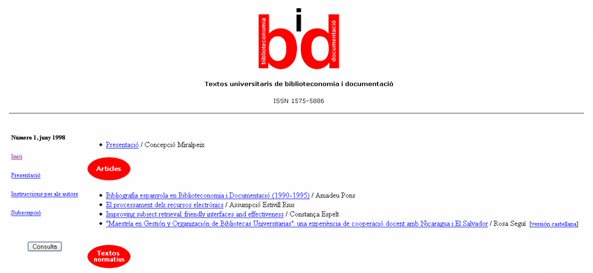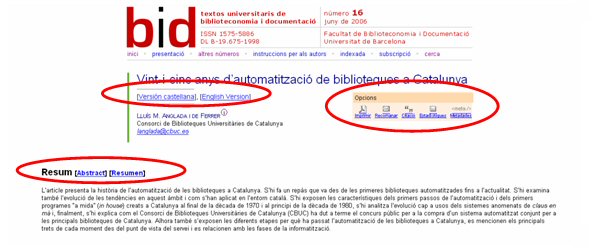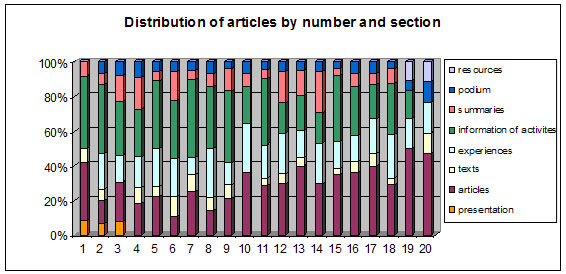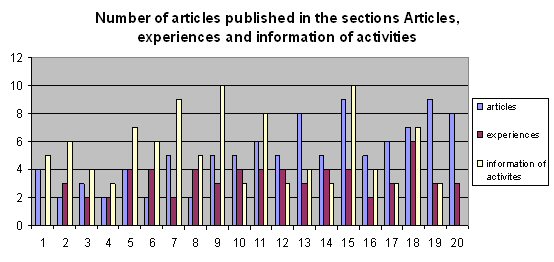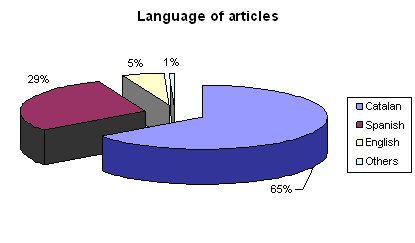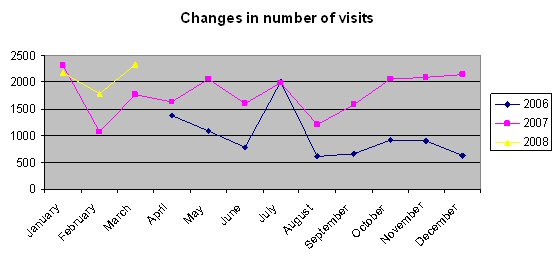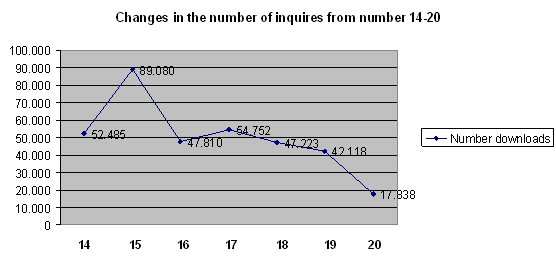Abstract [Resum] [Resumen]
The tenth anniversary of BiD has been commemorated this year and already has twenty-one issues. To celebrate 10 years of life we have prepared an article where it discusses the evolution of the publication throughout this decade. On the other hand, we have taken the incorporation of the Advisory Council on the latest issue because they discuss the strengths and weaknesses of the publication.
1 Introduction
To commemorate the publication of the twentieth edition of the magazine we wanted to do a review of content and distribution of the work done throughout the first decade of life. Other headlines have made revisions of the path to celebrate anniversaries, for example Resources Library & Technical Services (Connell, 2007). Connell makes a broad review of the fifty years of life of the magazine. The author analyzes a wide range of variables, such as the type of published materials, materials allocated to each item, the citations made and received, the authorship and gender.
In the Spanish State have done also similar revisions, such as the article of Pérez Álvarez-Ossorio (1997) which analyzes the overall themes dealt with by Revista Española de Documentación Científica for the first 20 years. The study also reflects the institutional origins of the texts published, as the authors also more productive. In Catalonia, Item (Gascón, 2002) published an article of the summaries of the 30 numbers which are compiled indexes of subjects, authors, works as given, and affiliations of the authors of the summary of the 30 numbers.
About BiD: textos universitaris de biblioteconomia i documentació, is not the first time they were publishes texts on their own contents of the header. There is a brief overview of Rodríguez (2001), which describes the sections and the general characteristics of electronic publishing, and the text of Abadal (2006), which goes over larger sections and the main features of the magazine, just after the 8th anniversary.
This article is divided into two central themes. In the first offer a retrospect of the evolution of BiD during these 10 years: it reviews content (sections, themes and languages) and dissemination of the magazine. In the second we give voice to the experts of the discipline that are part of the new advisory board, we discussed the strengths and weaknesses of the publication, in order to improve it.
2 Looking back
Since the birth of BiD the June 1998 until the present day has passed a decade of changes in the discipline of Library and Information Sciences which are in part reflected in the subject of the texts published during 10 years. This article aims to review developments in the magazine at all levels.
2.1 BiD: a purely digital magazine
BiD was born as a tool for asset disclosure by the Escola Universitària Jordi Rubió i Balaguer and has evolved into a consolidated publication in this area. From its foundation has tried to be a pioneer in various aspects, such as has been one of the top journals in the discipline who was born only in the digital version. They also wanted to be a field of experimentation for information technology, and it has also made extensive use of the Dublin Core metadata.
Since its inception BiD has a biannual issue, with a number in June and the second in December. The publication used as a majority language of their texts Catalan, though it has increasingly incorporated multilingual texts either with the Spanish version or English.
The next image is a screen print of the first head of the magazine, which came out in June 1998.
Figure 1. Headline of the first issue of BiD
In 2004 opted to change the design, introduced a new header that has remained until today. They deleted the file left side which became incorporated under the title, and also made slight modifications to the typography of the texts. The next picture shows the new head of the magazine with the design change.
Figure 2. Navigation bar higher with the new design
As you can see the new horizontal navigation bar has 7 sections: "home", "presentation", "other numbers", "instructions for authors", "indexed", "search" and "subscription". The section of "presentation", as it said the same word introduces readers to the magazine and is also present from the previous number 20 members of the Advisory Council. "Other numbers" would be equivalent to the archive of the magazine, it can be accessed in full and free all copies that are ordered by numbers. "Instructions for authors" explain all kinds of details must be submitted as text (size, typeface, format images, the format of quotations and footnotes, etc.). "Indexed" contains a listing and the respective links with all the databases that are indexed journal. "Subscription" includes a form which allows you to receive the magazine or subscribe to the syndication of content depending on the definition of substances of concern. Finally, "search" is the point where the user can find articles at Temaria <http://www.temaria.net> by either simple or advanced search.
BiD offers readers various value-added services such as consulting the summary of articles in English and Spanish. In addition some items can be automatically translated into English and Spanish through Internostrum <http://www.internostrum.com>. The other options let you print to PDF, to recommend the text by e-mail, you can see the recommended citation or bibliographic note, there is the option to view detailed usage statistics (date, time, organization and domains) and see the metadata assigned to each text. The following figure contains a selection of value-added services discussed in the preceding paragraph.
Figure 3. Value-added services in an article
2.2 The contents: sections, subjects and languages
Since its last two numbers the content is organized into five sections: "gallery", "articles", "experiences", "texts" and "resources". But from the beginning we could find six. The "gallery" usually open with a topical issue by an expert; "items" include the texts of any branch of the discipline that have passed the assessment of the reviewers; "experience" takes initiatives, projects, viewpoints oriented to the exercise of the profession; "texts" basically contains translations of standards, guidelines and principles; information activities is an area devoted to the congresses, conferences and seminars, and finally "reviews", which makes an assessment of resources and Web applications.
Evolution of BiD and sections is due to the transformation of the discipline. If in the beginning had a desire to spread the activities and experiences of the Faculty over the years this has become internationalized. For this reason the theme of the original text was based on aspects of teaching, activity reports, memoranda, congresses, most of which were written by professors from the Department. Beyond the stage of birth of the magazine during the growth period were incorporating other authors, all of the discipline or closely related, but different backgrounds. The opening brought the publication of thematic more diversified. Today, with the inclusion in the latest issue of the Advisory Council composed of national and international specialists, we want to give a bonus of quality and expertise and external review of published material.
In reviewing the 20 numbers we have found it convenient to analyze the global production of BiD and also go into sections as Items, experiences and information activities, since they are the ones who receive more documents. In the next graph we show the total number of texts published in each section of BiD up over the 10 years.
To make the figure we have collected data, copy to copy from each of the texts of 6 sections of the magazine. As can be seen in Business Information (green) and Articles (pomegranate) are the two most productive sections, where more texts have been published. It is interesting to see the continued growth of the articles, which is located in one of the highest points in the last two numbers (19 and 20). It can also be seen in the chart at number 19 and 20 there have been slight changes in sections.
Figure 4. Distribution of texts by number and section
To complete the picture and have total figures for each of the sections along the ten years we have prepared the table below, which is only a sum total of texts by section. The low number of texts from the Resources section and is due to the fleeting presence of the first and novelty of the second.1 The data indicate which sections are more important and certainly most interested readers.
Sections Total Presentation 3 Podium 20 Issues 102 Norms and regulations 20 Experiences 64 Information of activities 103 Summaries 32 Resources 4 Table 1. Number of articles published by section
From these data we put attention to the sections with more volume of content: "articles", "experiences" and "information activities". We have prepared the following graph where we can see that information texts of activities have some peaks in the numbers 7, 9 and 15, as well as articles do the same at 13, 15, 19 and 20. Respect the experience keep a record with the exception of the number 18 that stand out from the average, though often less than the other two sections.
Figure 5. Number of articles published in the sections Articles, experiences and information of activities
After reviewing data from each section we believed appropriately analyze the specific subject of each. To produce the following table we have used the portal Temaria (which incorporates BiD since his early days) to seek what are the major themes to BiD. An article can be classified in more than one category. It is for this reason the total number of tables 1 and 2 do not match.
The portal Temaria <http://www.temaria.net> uses 12 categories to classify the thematic content. We just comment that there are texts that have allocated more than one category the figures show a predilection for certain imbalance or some other thematic opposite. Museology, Linguistics and Language are the least represented, followed by Information society and Studies metric information. Archives gather a few texts as well. The Documental process is in a period between the still fairly remote science and Technical assistants, Information professionals and users, Sources of information and Library science. Lead with over a hundred texts information technology and communications, followed by units of information.
Thematic content Total Archival 20 Librarianship 89 Technical and Science Assistants 67 Metric Studies of information 19 Sources of information 71 Languages and linguistics 8 Museology 5 Documental process 42 Information professionals and users 70 Information society 16 Information Technologies and Communications 121 Units of information 104 Table 2. Number of articles by subject matter
Another element has been analyzed the language chosen by publishing the article and also quantify how many texts are written in more than one language. On many occasions published the same text in different languages is an investment of time or language skills important. To fill these gaps and possible have a wide spread the content of the articles are summarized in English and besides Internostrum offers automatic translation of some texts.
The graph shows a predominance of Catalan and a small number of texts in English. Predominantly bilingual contents in Catalan – Spanish, although recently added the English version. In addition, there are more users in the Spanish version of the articles that are available, the Catalan version, whereas downloads of the articles in the English language is less than the Catalan version.
So far there are 86 multilingual texts. In Figure 6 shows the percentages depending on the language of the article where there is a clear dominance of the Catalan language, even though the trend is to incorporate BiD second and third languages for wider dissemination of their contents.
Figure 6. Languages of articles
2.3 Readers: dissemination of the journal
So here we have a look at the productivity of the first ten years, but this would be lame if we do not supplement with figures for the dissemination of the magazine (available since April 2006 and tested until October 30, 2008). The following table lists, month after month, data from 2006, 2007 and 2008. As the figures show there is an increase in the number of visits per month, year after year.
Month 2006 2007 2008
(until 30 October)January n. a. 2.311 2.184 February n. a. 1.077 1.788 March n. a. 1.770 2.327 April 1.377 1.634 2.746 May 1.081 2.050 2.727 June 788 1.604 2.967 July 2.008 1.989 2.159 August 604 1.201 1.705 September 668 1.584 2.760 October 916 2.050 3.391 November 905 2.097 n. a. December 629 2.135 n. a. TOTAL 8.976 21.502 24.754 Table 3. Hits per month
The same data in Table 3 we have become a chart where you can appreciate, with a glance, the upward trend since 2006. Unfortunately you can not visualize the three full years, because surely we could detect the two points of maximum spread the months of June to July and December-January, coinciding with the departure of the two copies.
Figure 7. Changes in the number of visits
The figure below shows the trend in the number of visits from the number 14 of the magazine until 20. The statistics were taken from the same BiD provided, number to number, and article to article downloads. These figures also include consultation downloads that make crawlers search engines. The graph shows a decrease in the number of downloads, but you must be borne in mind that the last number just six months ago, which can be found. On the other hand, the number 15 is the highest point of downloads (see Table 4).
Figure 8. Changes in the number of inquiries from numbers 14-20
Table 4 lists the ten articles most consulted. The total data downloads of each article takes into account the versions in other languages, namely, have joined the total number of languages. The numbers 14, 15 and 16 are those that collect, for the moment, articles with more visits. You can see a big jump section to the second most consulted, and it is a tenth the number of downloads more gradual.
Journal number Top ten articles Total downloads 15 Bitácoras y sindicación de contenidos: dos herramientas para difundir información 40.458 17 Cincuenta ideas para sorprender desde la biblioteca pública 11.089 16 Análisis comparativo de editores de mapas conceptuales de uso libre 8.521 14 Informe de les IX Jornadas Españolas de Documentación, FESABID 2005 (Madrid, 14 y 15 de abril de 2005) 6.140 19 El uso de la norma de calidad ISO 9001 en las bibliotecas de instituciones de educación superior 4.949 17 Pasado, presente y futuro de la Web 2.0 en servicios de información digital 4.692 16 Los estudios de Biblioteconomía y Documentación en los países del Espacio Europeo de Educación Superior 4.365 16 Expurgar: por qué, cómo y cuando 4.179 15 Aproximación al movimiento open access 3.870 14 La biblioteca pública como servicio: dónde estamos y qué nos falta 3.783 Table 4. Articles with more visits
It is interesting to have other information on the number of visits, such as page views per session. The user sees BiD nearly two pages per visit with a duration ranging from one minute and a half to two minutes. Obviously with this period of time is impossible to read an article, but surely it is time to send it to print or save it to PDF.
2006 2007 2008
(until 30 October)Average page views per visit 1,94 1,84 1,71 Average time per visit (min.) 2:04:00 1:55:00 1:35:00 Table 5. Average number of pages viewed per visit, medium and long
It is necessary to comment that the data in the table 5 are biased because of the large number of occasional users who occasionally come to the Web BiD and that lowering the average time per visit with a visit sporadically (between 0 and 10 seconds), as specified in Table 6. We can see that in the three years analyzed the largest percentage part of the strip temporarily from 0 to 10 seconds per visit. From Area of the Marketing and Distribution of the magazine BiD is considered necessary to improve the quality of number of visits (users who are more than a minute on the web), as more than 80% of users are a maximum of 30 seconds.
2006 2007 2008
(until 30 October)Visits % Visits % Visits % 0-10 seconds 6.507 72,50 % 16.239 75,50 % 20.029 80,91 % 11-30 seconds 308 3,40 % 663 3 % 606 2,45 % 31-60 seconds 286 3,20 % 612 2,80 % 600 2,42 % 1- 3 minutes 603 6,70 % 1.303 6 % 1.244 5,03 % 4-10 minutes 683 7,60 % 1.437 6,70 % 1.299 5,25 % 11-30 minutes 503 5,60 % 1.058 4,90 % 937 3,79 % + 30 minutes 86 1 % 190 0,9 % 205 0,83 % TOTAL 8.976 21.502 24.754 Table 6. Length of the visits
I respect the provenance of the readers, tops the table the Spanish state, and in second position during the three years remains the United States, followed by Mexico (in reverse order according to data from 2006 and 2007). There is a wide gap in the percentage of visitors from Spain (around 70% in 2006 and 2007 and 60% in 2008) to respect the second country that accumulates 5.6% in 2008. The troop more visits are mostly from Latin America.
2006 2007 2008 Country Visits % Country Visits % Country Visits % Spain 6.771 (75,4 %) Spain 15.520 (72,2 %) Spain 15.005 (60,6 %) USA 334 (3,7 %) USA 946 (4,4 %) USA 1.378 (5,6 %) Mexico 254 (2,8 %) Mexico 773 (3,6 %) Mexico 1.045 (4,2 %) Argentina 225 (2,5 %) Argentina 449 (2,1 %) Venezuela 913 (3,7 %) Chile 146 (1,6 %) Chile 398 (1,9 %) Colombia 877 (3,5 %) Colombia 117 (1,3 %) Venezuela 343 (1,6 %) Argentina 759 (3,1 %) Peru 83 (0,9 %) Colombia 322 (1,5 %) Peru 560 (2,3 %) Venezuela 82 (0,9 %) Germany 243 (1,1 %) Germany 494 (2,0 %) Germany 61 (0,7 %) Ireland 179 (0,8 %) France 298 (1,2 %) Nicaragua 61 (0,7 %) France 177 (0,8 %) Nicaragua 219 (0,9 %) Brazil 56 (0,6 %) Nicaragua 174 (0,8 %) Ireland 218 (0,9 %) Italy 56 (0,6 %) Peru 157 (0,7 %) United Kingdom 173 (0,7 %) France 49 (0,5 %) Brazil 113 (0,5 %) Chile 152 (0,6 %) Ireland 49 (0,4 %) Italy 103 (0,5 %) Canada 149 (0,6 %) Portugal 40 (0,4 %) Filipinas 99 (0,5 %) Ecuador 149 (0,6 %) Guatemala 39 (0,4 %) United Kingdom 93 (0,4 %) India 142 (0,6 %) United Kingdom 39 (0,4 %) Portugal 91 (0,4 %) Txec Republic 141 (0,6 %) Filipinas 35 (0,4 %) Ecuador 91 (0,4 %) Cuba 127 (0,5 %) Costa Rica 35 (0,4 %) Cuba 80 (0,4 %) Brazil 126 (0,5 %) Table 7. Geographical Origins of the visits
3 The voice of the experts
We wanted to take advantage of two aspects converge the publication of 20 numbers and incorporation into the magazine's Advisory Council to complete the article and take stock of the trajectory. We have been in touch with each person making up the Council to order what they value most aspects of the magazine and what are its weaknesses. The following paragraphs are a result of their perceptions.
Some Council members have stressed that BiD has a good positioning and good spread both in Catalonia and in Spain. For example, the rate of impact as in-recs,2 2007 is 0,177, a figure that puts the magazine in fifth place, below Cybermetrics: International Journal of Scientometrics, Informetrics and Bibliometrics, El Profesional de la Información, Revista Española de Documentación Científica and Anales de Documentación. This fall of two positions at 2006 is due, surely, that BiD has become part of the list of source journals which the citations are counted. On the other hand, also appreciates the quality and confidence, namely the fact that the magazine publishes specialized professionals in their fields and contrasted with recognition.
Ranked as a strong design and typography which allows you to read and consult the magazine with ease. Closely linked to graphic design there are sections of the organization and content that maintain balance. Section texts is not found in other publications of the discipline and for this reason also is perceived as an advantage. Regarding the biannual basis is correct. The articles are of quality and innovative, though some people think they are very focused on the civil service. The thematic and geographic proximity makes it a magazine for reference in the professional field.
BiD was among the first publications to have the Creative Commons and since birth has been in open access.
So far we have collected the positive and beneficial. On the other hand, there is a continued aspects of which some members of the Advisory Council are weaknesses or challenges to the magazine, and therefore, could improve or implement. We have grouped into 20 points. The first block elements are related to the content, the second from 10 to 20 relate to aspects of consultation and dissemination.
- Backbone magazine in a central theme, this would give it more cohesive and better each issue. Perhaps in this new approach might try to always have an article that focused on the reality of Catalonia.
- Entering text aimed at professionals with a passion and the humanities formation.
- More relationship with other disciplines such as psychology, statistics, linguistics, and not just computers.
- Fill a paragraph related research activities of the faculties of library and documentation. It could be a space for presenting or make summaries of thesis, research groups and so on. And just to make them known to the community, both academic and vocational.
- Open the contents into new frontiers of the profession, but is already being done in a way.
- Modernizing the thematic areas of search, as they have become outdated.
- There is a lack of innovative articles calling into question what was being done and how.
- Put more emphasis on academic articles that analyze the reality of our immediate surroundings.
- Get more interaction between readers, authors, publishers accountable, and so on.
The following challenges as we have announced in the previous paragraph, are issues related to consultation and dissemination.
- Improve the accessibility and usability of the site: the navigation between articles in the magazine and is not as nimble as it could be.
- Could complete the metadata header.
- Entering the DOI (digital object identifier) <http://www.doi.org/>.
- Create the role of the magazine format because it is considered that it would increase distribution and presence on the shelves of libraries.
- Attempting to join ISI Web of Knowledge.
- Create an auto-automatic file to e-LIS of the articles.
- Reaching areas of greatest projection, dissemination and appreciation.
- Publication of all content in English.
- Explore what are the tools of Web 2.0 that could add value and add complementary.
- Incorporate a section of tools and technologies, similar to the new publications of the journals on paper, to support the management and development of libraries and information services.
- Improving the system of subscription and the distribution list to communicate news to users of the magazine.
So far we have reviewed the decade of life BiD with a retrospective look at different aspects of the publication. In conclusion, only congratulate them on the anniversary and to encourage them to get on the web 20 issues, plus at least.
Bibliography
Abadal, Ernest; Estivill, Assumpció (2006). "BiD: textos universitaris de biblioteconomia i documentació". Tk. num. 18.
Connell, Tschera Harkness (2007). "A look at fifty years of Library Resources&Technical Services". Library Resources&Technical Services, vol. 51 (4), p. 237-249.
Gascón, Jesús (2002). "Índexs d'Ítem, del número 1 al 30: matèries, autors, obres ressenyades i afiliacions dels autors. Recull de sumaris dels 30 números". Ítem, vol. 30, p.125-211.
Pérez Alvarez-Ossorio, José Ramón (1997). "Cobertura temática y procedencia institucional de los artículos publicados en la Revista Española de Documentación Científica en sus veinte años de existencia". Revista Española de Documentación Científica, vol. 20 (3), p. 290-298.
Rodríguez Parada, Concepción (2001). "BiD: textos universitaris de biblioteconomia i documentació". El profesional de la información, vol. 10, n.º 7-8.
Received: 25/09/2008. Accepted: 04/11/2008.
Notes
1 Table 1 is recorded in the light sections of the magazine, although not evaluated what they contain. Therefore, the results will have to assess with a certain relativity.
2 Index of the Impact of Spanish journals of social sciences. <http://ec3.ugr.es/in-recs/>.
